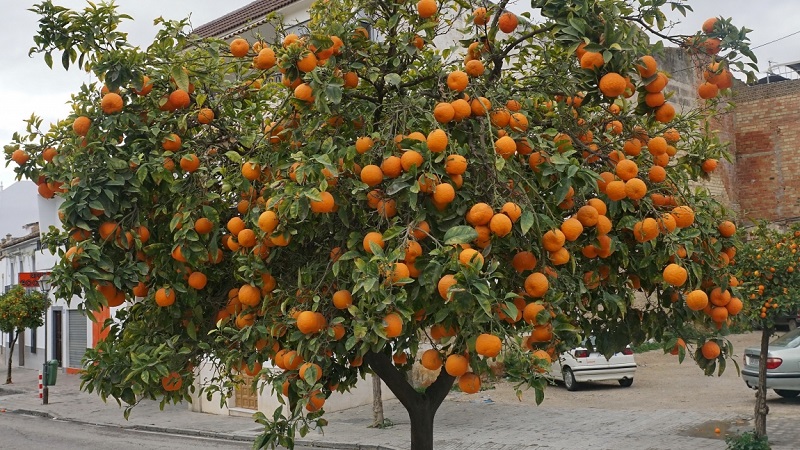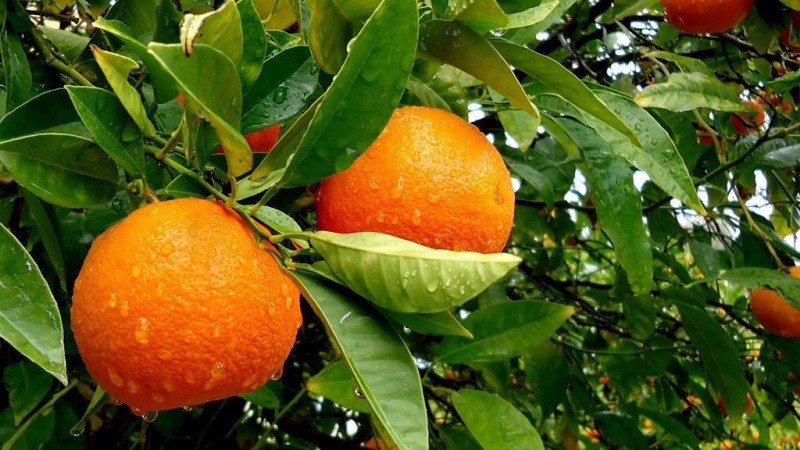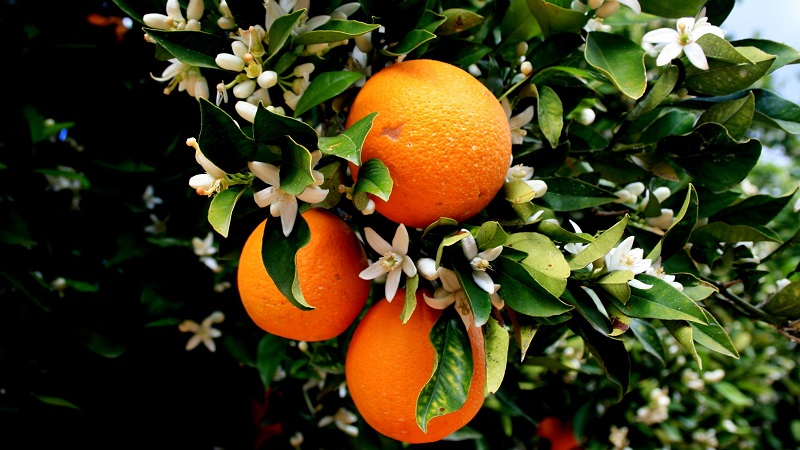What is an orange tree and how does it bloom
The bright and juicy orange as we know it is a descendant of citron and a hybrid form of mandarin and pomelo. Culture has a number of features that distinguish it from the "ancestors". The flavor, juiciness, color of the pulp and rind varies depending on the variety. The most popular are oranges with orange peel and sweet-sour pulp, with and without seeds.
What an orange is, what it looks like, where it grows, what features of the structure of flowers, leaves and fruits it has, we will tell in our article.
The content of the article
The history of the origin of the orange
The origin of the genus Citrus was studied by scientists from the USA, Spain and France. The research results showed that the first citrus trees appeared in Southeast and South Asia, then "migrated" to subtropical and tropical countries. Cross-pollination has resulted in lemons, oranges, limes, grapefruits and tangerines.
DNA research helped to establish the approximate period of citrus appearance - about 8 million years. This is confirmed by the found fossils dated 8-6 million years BC. e.

A Chinese manuscript dated 1178 describes 27 varieties oranges and tangerines.
Scientists suggest that the orange is the result of crossing a mandarin and a pomelo... The homeland of the orange, like that of other citrus fruits, is Southeast Asia. The fruits are distinguished by a special structure and are called hesperidia, like tangerines. This name was given to the fruit of the orange tree from the Greeks. One of the ancient Greek myths describes the garden of the daughters of Atlanta - the Hesperides. It was there that the fruits called golden apples grew.
Sweet orange came to Europe in the 15th century, thanks to Vasco da Gama... According to one version, it was he who brought the citrus tree after a trip to India in 1429.
There is another version, according to which Europeans got to know oranges thanks to the crusaders who brought them from Palestine along with lemons.
Until the 18th century, oranges were grown only in greenhouses. London, Paris, Petersburg. At that time, in Spain and Portugal, attempts were already made to grow trees in open ground, especially since the climatic conditions allowed.
Spanish and Portuguese colonizers contributed to the spread of the plant to Central and South America, West Africa... So the orange gradually conquered new territories and became the main fruit crop in the tropics and subtropics. Wild forms of the plant have not been found in nature.
Reference. The most extensive orange plantations are in Brazil, Iran, Spain, India, USA, Mexico and China.
origin of name
There are several versions of the origin of the plant name.:
- Some researchers suggest that the name of the fruit comes from the English apple of sin - "apple of sin" or Adam's apple. Scientists are sure - in the Garden of Eden, Adam ate not an apple, but an orange. Other researchers of the etymology of the name see in this only an accidental phonetic consonance.
- Most linguists are inclined to believe that an orange is a "Chinese apple", translated from the Dutch appelsien (appel - apple, sien - China).

Is it a fruit or a berry
Is orange a fruit or a berry? According to the botanical description, an orange cannot be called a berry or a fruit.... In the scientific literature, the fruit of the orange tree is hesperidia, multi-seeded, multi-nested fruits, but in structure they are still close to berries.The pulp is covered with a bright orange peel. These are characteristic features of other members of the Citrus genus: lemon, tangerine, grapefruit and pomelo.
Interesting on the site:
Using tangerine peels for maximum benefit
Botanical description
Orange (lat.Citrus sinensis) is a fruit tree from the genus Citrus of the Rute family, one of the most common citrus crops in the tropics and subtropics. Orange is distinguished by its special structure of the root system and remarkable external characteristics.
There are two main varieties of orange:
- bitter or Sevillian (orange, bigardia) with a bitter and tart taste and a pronounced aroma;
- sweet Portuguese or Valencian - the most popular, sweet orange with a pleasant sourness.
Additionally allocate: Jaffa orange with thick ribbed skin and umbilical (navel) with a protruding rudimentary fruit from under the skin. These are the juiciest oranges, with a sweet and sour refreshing taste.
What a tree looks like
Tree - evergreen, tall, belongs to the Citrus tribe, subfamily Orange... At a young age, the crown is dense, but compact.
Orange is a long-lived tree... At a young age, it grows and develops rapidly, the annual growth is 40-50 cm. The process of growing up and aging is slow. The average life expectancy is 75 years. Some trees reach the age of 100-150 years, and have a large and spreading crown, like an oak.
Young shoots and branches of branches have thorns and large thorns... The height of the tree depends on the variety, some forms reach 12 m in height, there are also dwarf forms - 4-6 m. Compact varieties with a height of 60-80 cm are grown at home.
Root system
Rhizome - superficial, without root hairs... They are replaced by small covers with colonies of soil fungi. Microorganisms interact with the tree to form a symbiotic bond. Mushrooms receive amino acids and carbohydrates, and give water and minerals available for assimilation.
First of all, the tree is saturated with a large amount of phosphorus.necessary for normal development. The growing colonies of mycelium increase the yield of the orange, but they do not tolerate the lack of water, low soil temperature and especially suffer when the rhizomes are exposed. Therefore, when grown in an open area, trees need additional moisture.
Leaves
The leaf blade is leathery, has a dark green color... Pointed oval shape. Size - 10x15 cm. Edges - solid, wavy or serrated. Small winged appendages are connected to the petioles through an intermediate articulation.

Orange leaves contain glands with essential oils.... Their scent is similar to that of flowers.
One leaf lives for 2 years. More than 25% fly around in February-March, another 25% - during the year. Healthy trees only shed old foliage.
Orange has one biological feature - foliage of different ages has different functions. Young foliage takes part in photosynthesis, while old leaves are a kind of reservoirs for nutrients, without which plant development, flowering and fruiting are impossible.
Under unfavorable conditions, the tree loses most of its old leaves., which leads to slow development, lack of flowers and ovaries.
Flowers
How does an orange blossom? Orange flowers are bisexual, large in size - about 5 cm in diameter... Petals are white, less often reddish, elongated ovoid. In the center of the perianth there is a long pistil surrounded by yellow stamens. Flowers form in leaf axils on young shoots that grow horizontally or vertically.
Orange flowers are collected in a brush of 6 pieces, rarely grow alone, emit a strong, pleasant aroma. Flower buds appear in March-April. They are in the bud stage for up to 30 days.
The petals open quickly, after which the fruits are tied... The process takes place at a certain air temperature + 16 ... + 18 ° С. At low or high temperatures, the buds fall off. After opening, the flowers live for 2-3 days. There are varieties without pistils, they bear fruit without seeds, and do not need pollination.

Fruit
Fruit differ in a rounded or broadly oval shape and structure, characteristic only for the subfamily of orange... Their scientific name is hesperids or oranges. They are multi-celled, multi-seeded, or seedless.
Consider what the orange fruit is made of. Outer shell or rind - soft, thick (5-6 mm), rough or smooth, covered with zest. The lower albedo layer is white and thin.
Depending on the varietal characteristics and the degree of ripeness, the peel makes up 17-42% of the fruit weight... Color - green, light yellow, orange and red-orange. The taste is bitter, the structure is dense or loose. Large glands contain 1.2-2.2% of essential oil.
Intercarp - the inner part consists of 9-13 lobules covered with films... The pulp is a large juicy cells (nipple sacs). The taste is sweet, sweet-sour or bitter-sour, depending on the variety.
The fruiting period depends on the growing region... In the Northern Hemisphere, the season lasts from November to March, but depending on the area and variety, the crop is harvested in September-October or April-May. In the Southern Hemisphere, oranges ripen in June-August.
Seeds
Repairability is another distinctive feature of the orange... The tree blooms and bears fruit several times during the same season. Blooming orange is simultaneously decorated not only by buds, but also by fruits of different ripeness. Fruiting lasts 8-9 months.
Surprisingly, but with a lack of sunlight, ripe fruits remain on the branches for a long time, turn green again in spring, and turn yellow in autumn. The pulp of these oranges contains seeds. They are of high quality, but the taste and nutritional properties of such fruits are significantly deteriorated due to the loss of biologically active substances.
Trees grown from seeds enter fruiting on average after 8-12 years, sometimes after 15-20 years. Plants obtained from cuttings and grafted give the first harvest in 4-5 years.
Reference. For the transportation of oranges in Argentina, the FMA I.Ae. 38 Naranjero. The name translates as "Orange Merchant" and "Orange".
Conclusion
Oranges originated from the cross-pollination of mandarin and pomelo. The homeland of the orange is Southeast Asia. The fruits have a special structure and the scientific name of hesperidium. The leaves and rind contain essential oils. Trees are characterized by remontant, that is, they bloom and bear fruit several times a season.
The fruits are tied strictly at an air temperature of + 16 ... + 18 ° С. Fruiting lasts 8-9 months, depending on the area. For example, in Spain oranges are harvested in November-March, and in Brazil in June-August.